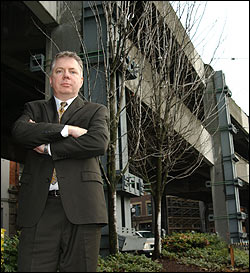The biggest surprise of a not-very- surprising election this year was the voters’ rejection of Initiative 912, leaving in place, at a time of very high gas prices, the Legislature’s 9.5-cent-per-gallon gas-tax increase. The state’s business, labor, and environmental leaders poured a lot of money into opposing I-912; still, it marked the first time in recent history that statewide voters rejected a tax-cutting initiative of any sort.
Pundits attributed this voter reversal in large part to the impact of Hurricane Katrina, which served as a reminder that, among other things, government has to do something about the Alaskan Way Viaduct before the next big earthquake strikes. But the new gas-tax money will help fund road projects across the state, and it seems more likely that the vote reflected just how fed up citizens from Bellingham to Olympia—an area that overwhelmingly rejected I-912—are with gridlocked traffic. The vote against I-912 is a mandate for politicians to make transportation improvements a high priority in coming years.
So what next? The gas-tax increase funds less than half of the money needed for the three biggest local roads projects: $2 billion of the $4 billion to replace the Alaskan Way Viaduct; half a billion of the $2 billion to $3 billion needed for a new Highway 520 floating bridge across Lake Washington, and $1 billion of the more than $3 billion needed to expand Interstate 405. Moreover, the gas-tax increase legislation passed last spring specifies that money for those projects goes away if regional voters don’t approve a parallel funding package before January 2007. And the Regional Transportation Investment District (RTID), the three-county agency formed in 2002 to craft a regional transportation ballot measure, has been deadlocked on what that ballot measure should look like.
Ed Murray isn’t worried. “The situation is evolving,” says the Democratic chair of the state House of Representatives Transportation Committee. “I think we’ve moved far beyond RTID.”
Murray, citing the RTID’s deadlock and the high cost of opposing I-912, doesn’t think there will be a regional transportation ballot measure in 2006. Instead, he has convened a group of agencies and political leaders that is negotiating a reform package that would completely overhaul the local alphabet soup of highway and transit agencies. The goal is a package that would replace RTID with an agency that would integrate local planning for highways and transit—and, eventually, that would seek supplemental funding for the highway projects in a package that would also include expansion of Sound Transit’s light rail to Northgate. And to have that package ready for January’s legislative session.
Murray dismisses the January 2007 deadline, noting that lawmakers can extend it. “I doubt the Legislature will pull money from the viaduct and 520,” he says. “That money needs to be committed to those projects. . . . I don’t think they’ll take it off the table. That’s the sense of the Senate, too.” But Murray doesn’t want the funding to come from higher sales taxes, the regressive funding mechanism RTID has focused on. He suggests, instead, some mixture of a regional gas tax, regional motor vehicle excise tax (MVET), and, for Highway 520, tolls.
Jon Scholes, on the other hand, does think there will be a regional transportation ballot measure in 2006, noting that RTID and Sound Transit, both of which are involved in the Murray-led negotiations, have been working toward that date for a ballot measure. Scholes is an aide to Democratic King County Council member Julia Patterson, another member of Murray’s group. He says the goal of the negotiations is to make future funding “more transit-friendly, and less reliant on sales tax.”
That’s fine and well, but significant barriers remain to finding more regional money for transportation—beyond the agency turf battles that make reform like that proposed by Murray both necessary and difficult. Most of the projects on the table are Seattle-centric; Snohomish and Pierce County voters are likely to resist taxing themselves for Seattle’s benefit. And Tim Eyman has already announced a new tax-cutting initiative drive for next year—targeting MVET, one of the mechanisms that might otherwise supplant higher sales taxes as a funding source.
Murray’s consolidation initiative is long overdue. The failure of the monorail taught us, if nothing else, the need to have transportation projects that are integrated, transparent, and accountable to the public. But beyond the projects now on the table, a lot more remains to be done, including the complete rebuilding of Interstate 5 through Seattle and finding some sort of transit replacement for the monorail Green Line that would have served West Seattle and Ballard had voters not killed it this month. All this will cost a lot of money—far more than if these projects had been tackled 30 years ago.
The failure of I-912 suggests an emerging consensus that local voters recognize the importance, to the economy and to our lives, of tackling the mess that Puget Sound transportation has become. The question is, how much are we willing to pay? We may find out in 2006.







